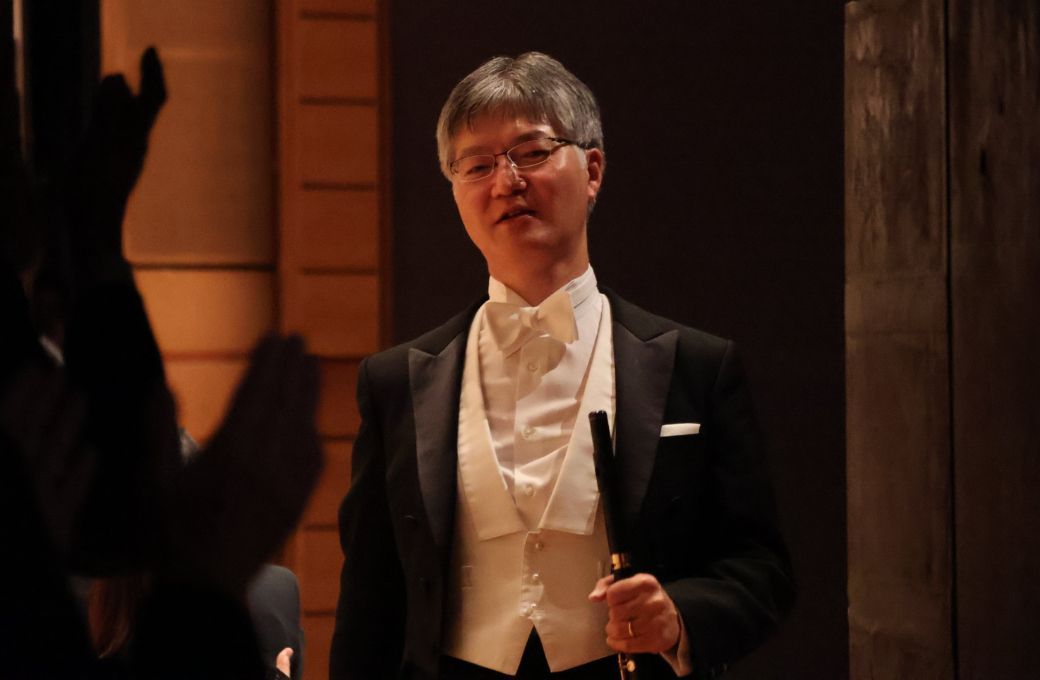Can you introduce yourself, and talk about your current musical role and responsibilities?
I joined the NHK Symphony Orchestra Tokyo in 1994 and became principal flute in 1999. It was around this time that Charles Dutoit, who will conduct Daphnis et Chloé in November, became our Principal Conductor (he took up the post in 1996).

When I joined, conductors such as Wolfgang Sawallisch (former Honorary Laureate Conductor) and Horst Stein (former Honorary Conductor) were still very much active, and the NHKSO was seen as an orchestra specialising in the Austro-Germanic repertoire.
The biggest change under Dutoit was the timing of the sound. Previously, there was a slight moment between the baton being lowered and the sounds being produced, but Dutoit demanded we produce the sound immediately. Over time the orchestra’s sound changed, and we began to perform more French and Russian repertoire and give numerous concerts abroad. I feel that I have witnessed the NHK Symphony Orchestra’s transformation firsthand.
In a work like Daphnis et Chloé, where the ensemble is complex and there are a lot of players, I tend to act as a “torchbearer” or “coordinator” of the woodwind section, together with the principal oboe. It’s partly to do with where we are positioned in the orchestra.
There is another principal flutist in the NHKSO, Masayuki Kai, but the two principals don’t usually appear together in the same concert. In Daphnis et Chloé, I will play 1st flute.
Ravel’s Daphnis et Chloé is a famous ballet, but has also become a classic piece of orchestral repertoire. Can you give a short introduction to this unique piece?
It is written for huge forces. The work requires a large number of instruments, but Ravel uses them effectively, depicting a wide array of colours from dazzling light to near darkness. It is also a piece that demands skilled technique and concentration from all players.
It’s a work I’ve played often, and I can vouch that not a single piece of detailed information contained in the score can be considered unnecessary. Therefore, when performing, the players must figure out how these details will be combined. It is challenging but rewarding.
The flute has a famous solo called Pantomime, an essential repertory for us flutists. It’s almost always a requirement at orchestral auditions.
Can you talk a bit about your own role as principal flute in this complex work?
If I were to compare the flute’s role within the orchestra to a plant, I would say the flute would be the flower rather than the root or stem or leaves (although the flower can lose its petals...). 20th-century French music requires the flutes to play in the high register to express brilliance, colours, and to be decorative. In Daybreak the flutes and piccolos play the role of birds. Wagner, by the way, also gives us birds, but not much else!
As principal, I rarely feel the need to “coordinate” the flute section because our 2nd and tutti players are all excellent, and they are skilled at bringing out their individual abilities while maintaining overall harmony. Therefore, I can just look at my own part and play, and the ensemble will naturally take shape. It’s easy when performing with trusted colleagues. I’ve never had to think much about the responsibility as principal player.
Ravel’s woodwind writing is famously virtuosic. As well as important solos for the flute, are there other woodwind highlights you would particularly point to?
Just after the Pantomime solo, there is a fast-descending scale passage which begins on the highest note on the piccolo and then is handed down seamlessly to 1st flute, then 2nd flute, and finally alto flute. This is the most difficult section for us, and especially tricky for the players joining mid-way. It must form a single line, and Dutoit will rehearse this section very precisely. Many other instruments, be it woodwind, brass, or percussion, have prominent solos, and it is a challenging piece for every player.
In a large piece like this one, how do you work with your woodwind colleagues, and those in other sections of the orchestra?
So long as you play exactly as written in the score, the music should flow and connect. Dutoit is very strict about pursuing this exactness. He demands that the rhythms and tempi are absolutely accurate. Before he came, we had always thought that we had been playing accurately, but the level of perfection that he demands is of a different order of magnitude.
While it’s important to understand what the conductor is seeking, what is crucial is to play exactly as written. For example, in Ravel’s case, the dynamics are all indicated in detail in the score. Still, not all the subtle nuances can be written, and this is where we bring out the “scent of Ravel” that Dutoit has instilled in us over thirty years. In the three decades I’ve been with the orchestra, many members have changed, but I feel what we have learnt from our maestros such as Dutoit and Sawallisch are being passed down to the younger generation.
As I often tell my students, being 1st flute is easy because you don’t have to worry too much about fitting in with somebody. Obviously the 1st flute has to coordinate with the orchestra leader, principal cello, and 1st oboe, but the 2nd flute has to play perfectly together with the 1st flute, and this is very challenging. During the NHKSO’s recent European tour, I played 4th flute in Mahler’s Fourth Symphony, and I found it very difficult because of the distance from the 1st flute player. I would say that the job description of the 1st flute is totally different from that of 4th flute. The 1st often plays solos, so rather than following someone, it’s necessary to take the initiative and play actively.
What impression did the work make on you when you first heard it?
The first time I heard the work properly was when I played it for the first time – I played 2nd flute under Michel Plasson in 1994. As it is a famous piece, I thought I knew it... Ravel is a composer I’ve always loved and it’s a wonderful piece and I remember I was happy to perform it, but it was extremely difficult, and it was a struggle just to keep up.
Is there a recording or a memory of a performance that is particularly special to you?
In fact, I’ve not yet played 1st flute in Daphnis et Chloé under Dutoit. The most memorable conductor for me in the piece was Pierre Boulez. There are groups of twelve notes for the flutes and clarinets in the beginning of Daybreak which is very tricky, but some conductors move the tempo there and we are at a loss to what we should do. However, Boulez was different. He would never do unwritten ritardandos, and although all he did was to beat time as if to a metronome, a huge sound would rise, creating surges. I also remember performing the work with Andre Previn (former Principal Guest Conductor), Vladimir Ashkenazy (Conductor Laureate), and more recently with Juanjo Mena.
Do you have a personal favourite passage in Daphnis et Chloé?
Of course, I love the Pantomime which is a highlight for the flute. I also love the Nymph’s theme that appears just after opening of the piece which the flute plays. It’s also exciting when the whole orchestra plays very fast in the Danse guerrière and Danse générale. Another highlight of this piece is the acrobatic interplay between the flute parts, which is very rewarding to play.
What guidance would you give to listeners and performers new to Ravel’s music?
Daphnis et Chloé is Ravel’s largest orchestral work. There is a lot of contrast, from the quiet passages to the fast and furious, and the dynamics range from pianissimo to fortissimo. I hope you will enjoy the various elements packed into this piece.
Above all, I hope you will enjoy the “scent” of Ravel’s music. Not “smell” but a faint “scent” that wafts in the air. It was Charles Dutoit that managed to bring out the “scent” in music which previously the NHKSO lacked. All you need to do is to come to the concert hall and enjoy that scent. You won’t be bored by this music. There are various details you can dig into, or alternatively you can focus on the story of the ballet. Listen out for the virtuosic playing of the various instruments.
Why should one come to hear a performance of Ravel’s Daphnis et Chloé?
For a start, this year is the 150th anniversary of Ravel’s birth. Daphnis et Chloé is one of the most brilliant and magnificent pieces of music composed in France in the era. There are many “scents” in this piece including some exotic ones. Once you listen to it, you will surely be enchanted. Furthermore, Daphnis et Chloé is a work that symbolizes the partnership of Dutoit and the NHKSO, alongside the Rite of the Spring. We hope to see you all at the performance.
The NHK Symphony Orchestra performs Ravel’s Daphnis et Chloé on 14th–15th November.
See all upcoming performances by the NHK Symphony Orchestra Tokyo.
Translated from Japanese by Nahoko Gotoh.
This article was sponsored by NHK Symphony Orchestra, Tokyo.


